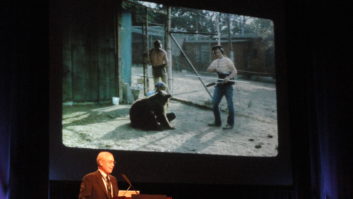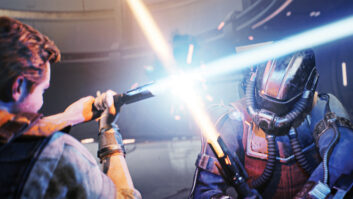By Clive Young.

The creation of the Star Wars films is a story that’s been explored countless times through TV specials, DVD extras, books and more. One aspect that’s only been lightly touched upon, however, is the extensive sound design that went into the various movies, much of it developed and recorded by legendary audio man Ben Burtt. His contributions—and fascinating stories—are now being put in the spotlight through a new book, The Sounds of Star Wars.
The tome dives deep into the creation of other-worldly audio effects for the films, often with Burtt himself describing how a sound came to be. In his hands, a hammer striking a high-tension wire becomes a blaster; a buzzy TV tube and film projector create the whirr of lightsabers; and a braying jackass becomes the howl of desert nomad Tusken Raiders.
While many of these sounds are emblazoned in the minds of millions of people, the book comes with a built-in audio unit that plays more than 250 isolated sounds. Paired up with appropriate film stills and text on how they were created, the sounds creates a multi-sensory experience. All this can be heard through a small speaker on the unit, but in a nice touch, there’s also a headphone jack so you won’t drive everyone around you crazy—unless you want to, of course.
While the book is clearly meant for the masses, there’s plenty for audio pros to chew on, as the book runs down the audio gear used from film to film. Working in 1976, Star Wars was tackled on TEAC A-7300 and 33405 tape recorders, a Nagra IV-S half-track stereo recorder and a Nagra II, with a Urei 565 universal filter bank thrown in for good measure. By the time they began working on Return of the Jedi in the early Eighties, the gear had expanded to include a machine room based around Magna-Tech 35mm 4/6-track recorders and a Dolby CP200 cinema processor.
As the book continues right up to 2005’s Revenge of the Sith, there’s plenty to read up on and discover, but small detours are taken to acknowledge other parts of cinematic sound history, including a sidebar on Treg Brown, the mastermind behind the classic Warner Brothers cartoon sounds, and a short history of the infamous Wilhelm Scream.
Also scattered throughout are insights and advice from Burtt, gleaned from years in the audio trenches, such as this anecdote about mixing parts of Return of the Jedi:
Normally, a mix goes from beginning to end, in continuity. “But we actually began work in the middle,” says Burtt. “We started with reel five because there were scenes in the earlier reels that hadn’t come together yet and the special effects were not completed. It’s not a great way to work, doing it out of context, because there’s always a natural flow and feel for the sound as it develops through the movie.”
Because reel five had the triumphant arrival of the Emperor on the Death Star, the volume of the scene was pushed to the limit. “We had fresh ears at the beginning,” says Burtt. “However, everyone was nervous about having the whole responsibility of the mix as well as the fear of failing to grab the audience. We tried to ease our fears by making the arrival really loud. The music got pushed all the way. Later, after we’d finished the whole mix, that scene still jumped out as being over the top. This kind of thing happens commonly on a mix. The producer, director, and mixers think sheer volume will solve all your dramatic problems. It doesn’t. I’ve learned this lesson over and over again.”
That, along with plenty of other lessons, history and amusing anecdotes, can be found in the pages of The Sounds of Star Wars, an enjoyable and occasionally inspiring addition to any sound person’s library.







